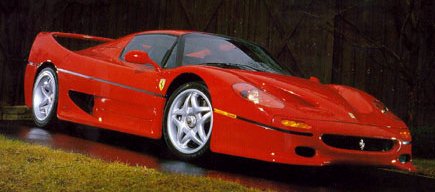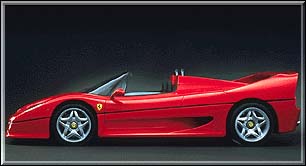Ferraris
![]()
Pictures | Information | Tech Spec | Books
![]()
![]()
Pictures | Information | Tech Spec | Books
![]()
Ferraris are one of the ultimate status symbols, everybody wants a Ferrari, The Ferrari Testarosa is a favourite for many all around the world. Its sleek design and beautiful lines are simply timeless, although some would say it's looking a bit old these days, so what about its new cousin, the Ferrari F50, is the replacement for the F40, which in my opinion, is slightly better looking than its predecessor, but what do you think have your say in our interactive Ferrari Poll below. There is also of course a baby in the Ferrari family, the Ferrari F355. Read all about these great cars and more such as the 550 Maranello, the F456 GT, with articles and tech specs for each and see many pictures of these beautiful cars. You can also buy discounted books from Amazon.com about Ferraris from here.
![]()
Ferrari F355
In 1994 Ferrari replaced the 348 with the F355. Basically, it is still built on the same chassis and engine structure, but several minor modifications completely transformed its road manner. In addition to the enhanced performance, F355 not only revenged successfully but also raises itself into a class of its own.
The Main Modification are:
Engine: Base on 348's V8, Maranello has added 2mm to the stroke so that capacity increased slightly to 3.5 Litre Conrods are now made with Titanium to reduce inertia. A butterfly valve was allocated to each cylinder rather than one per bank as before. But the most decisive change is the 5-valves cylinder head. It enables smoother breathing so that specific power output is raised to a world record 108.7 BHP/litre from 88.1 BHP/litre, dramatic! No other normally aspirated engine could be more impressive, except F50's F1-derived engine.
Chassis: The wheelbase did not change, but the front track is 12mm wider and the rear up by a huge 37mm. It is also 30 percent stiffer. Engine cover and bonnet cover are made of carbon fiber, so is the flat undertray which was introduced to reduce lift and equalise downforce on each axle.
Suspension: Still double wishbones in all corners, but the springs are softer, the anti-roll bars stiffer and with new self-lubricating bushes. The electronic damping control used in 456GT is added.
Steering: Steering is now power-assisted and revised geometry increases castor action while reducing compliance in the linkage.
Ferrari F456 GT
I love this car loads, for many reasons; First of all, it is very stylish. Pininfarina said it is inspired by the Daytona, one of the best looking front engine sports car of all time, but in my opinion 456 GT is better because it combines curved surfaces with sharp edges in the most perfect way. It is best viewed from the rear, but from the front or side it is still beautiful enough to beat most other front engine cars.
Secondly, I love its quality and luxurious cabin. Even the best British craftmen can hardly make better leather seats and trim in style. Moreover, the spacious cabin can seat 4 adults without difficulty. Ferrari has improved its build quality a lot in recent years. It even introduced robotics to upgrade the quality, not productivity. Among its model line-up, the 456 GT is unquestionably the best built.
Thirdly, the 456 GT has a wonderful power train - its 5.5 litre V12 is so powerful (442 BHP) and smooth that no other competitors can match it. Compare it with Aston Martin's superchaged V8, the Maranello traditional V12 is overwhelmingly smoother and sounds a lot more beautiful. Compare it with the BMW 850 CSi's sohc motor, the 456 GT's is a lot stronger and sporty, with similar refinement. The engine is mated with a close ratio 6 speed manual transmission through a long linkage, since the gearbox is located near the rear axle (transaxle) in order to provide a 50/50 weight distribution. Although the linkage is long, gearchange is precise. A light clutch and an optional automatic gearbox would satisfy those who demand more driving ease, especially Americans.
Fourthly, its handling is very nimble, if not as involving as other lighter and sportier Ferrari models. Considering its size and weight, the 456 GT's handling is nothing other than remarkable, beating all other GTs convincingly. It's ride is one of its strongest points, which is very important in this class. It has an electronic damping system with 6 different settings. The Computer chooses the best setting according to the steering angle, speed of steering inputs, brakes and road speed. It works really well.
Ferrari 550 Maranello
The 550M is not an all-new design, in fact it is based on the 456 GT. While the 456 GT aims at the luxious 2+2 GT market, the 550M is designed to replace the mighty Testarossa / 512TR / F512M series as the company's top-of-the-range production sports car. Actually, Ferrari shortened 456's platform and cut the rear seats to make 550's chassis. The rear-mounted gearbox is retained with a few modifications to change the ratio and strengthen it. Suspensions and electronic damping are carried over with minor tuning. Since the 456 GT's V12 is already powerful at 442 BHP and 405 ft-lb, Maranello needs no more than a ram-air device to boost 43 BHP and 15 ft-lb. All these changes sound conservative, but lower development cost really helps keeping the price under the 456 GT.
The 550 Maranello is faster than its predecessor - 0-60mph in only 4.3sec, that is 0.4sec faster than F512M. Stronger bottom end torque and six speed box account for this improvement, although it weighs nearly 1700 kg! Even more impressive are the brakes. For a long time brakes were often Ferrari's weak point, but now 550 Maranello has probably the strongest brakes in production - even beats the Porsche 911 turbo to stop from 100mph!
Nevertheless, the 550M still lacks the ultimate thrills that the most demanding drivers require. Despite its precise to control, it is not as sharp in handling as the F50, McLaren F1 or even the Lamborghini Diablo SV. If it were lighter, and not as easy to drive, it would be more thrilling.
Ferrari F50
The F50 is the logical successor of F40, which was so successful that about 1200 cars were built. After the failure of the Jaguar XJ220, Yamaha OX99-11 and other expensive super cars, Ferrari is more conservative on pricing at £329,000. It also guarantees that no more than 349 cars will be built. (It once guaranteed that only 500 F40s would be built, it turned out to be 1200 so that resale price fell considerably and hurt the image of the company.)
The F50's engine is unquestionably the core of the car, with 4.7 litres, the high reving 5 valves per cylinder V12 is capable of a record-breaking specific output of 109.2 BHP/litre, eclipsing the F355's 108.7 BHP/litre to be the most efficient normally aspirated engine. Combining with the light weight of 1230 kg and close-ratio 6 speeds box (which compensates for the less impressive torque of 347 ft-lb), 0-60mph can be achieved in only 3.6sec, which is only eclipsed by the mighty McLaren F1.
The chassis is also extraordinary. Carbon fibre is inevitable, but the whole chassis and suspensions are bolted on the engine / transmission like Formula One cars, thus producing an ultra-rigid and simultaneously light structure. If it were not open top and being so big, it would have been probably lighter than McLaren F1's 1138kg.
On the road, the F50 is very stable, accurate in handling at any speed, and the huge tires and down force generated by the big rear spoiler enable high speed cornering stability. It runs faster than the F40 on race tracks, thanks to a better chassis, but slower at mid-range acceleration than the 425 ft-lb predecessor. Because the F50's engine is so highly tuned, it enables less room for improvement compare with the turbocharged F40. Ferrari used the F40 as their GT racer. But in real world, without modifications, the F50 is far faster than the F40.
The sad story of the Ferrari F50 GTE is told in the GT Racers section.
The F50 is also relatively easy to drive than other exotic supercars like the McLaren F1, XJ220 and the Lamborghini Diablo. But it is not better made. Everything is for performance enhancement, so don't expect McLaren's 10 disc CD changer and Bugatti's wood and leather cabin. Dashboard and other interior trimming are black carbon fiber. Racing bucket seats have no adjustment.

|
| Ferrari F40 |

|

|
| Ferrari F50 |

|

|

|

|

|
| A very rare shot of the abandoned F50 GT |

|
|
An artists impression of the new F355 produced from various spyshots |

|
| The Ferrari F355 |

|

|
| The Ferrari 456 |

|

|

|
| The Ferrari 550 |

|

|

|
| The Ferrari Testerosa |
Click here to see larger ferrari pictures, and wallpaper images, including F40s, F355s, the logo, and the largest Ferrari traffic jam ever.
Tech Spec
Ferrari F40
Engine: 2.9 Litre, V8, Dual Turbo
Compression Ratio: 7.8:1
Max Power: 478 BHP @ 7000 rpm
0-60: 3.8 secs
Top speed: 201.3 MPH
Weight: 2425
Ferrari F50
Engine: 4.7 Litre, V12, 48V (These are the engines used in Alan Prosts 1990 F1 car)
Compression Ratio: 11.3:1
Max Power: 520 BHP @ 8500 RPM (394 BHP per tonne)
Max Torque: 347 ft-lb @ 6500 RPM
0-60: 3.7 secs
Top speed: 202 MPH
MPH per 1000 RPM: 22.3
Length: 14.7 ft (4480 mm)
Width: 6.5 ft (1986 mm)
Height: 3.7 ft
Weight: 2712 lb (1230 kg)
Fuel Economy: 11 MPG
Price: £329,000
Ferrari 355 Spider
Engine: 3.5 Litre, V8, 8 cylinder
Max Power: 380 BHP @ 8250 RPM (248 BHP per tonne)
Max Torque: 268 ft-lb
0-60: 4.6 secs
0-124 (200 km/h): 15.5 secs
Top speed: 183 MPH
MPH per 1000 RPM: 20.8
Weight: 1422 Kg
Length: 4250 mm
Width: 1900 mm
Fuel Consumption: 17 MPG
Price: £103,735
Ferrari 456 GT:
Engine: 5.5 Litre, V12
Max Power: 442 BHP
0-60: 5.1 secs
Top speed: 186 MPH
Weight: 1823 Kg
Price: starts at $220,000
Ferrari 550 Maranello:
Engine: 5.5 Litre, V12
Max Power: 485 BHP
0-60: 4.3 secs
Top speed: 195 MPH
Weight: 1690 Kg
Price: Starts at $200,000
![]()
|
| |
| The adjacent Ferrari related books can be bought from Amazon.com at major reduction to normal shop prices (up to 40% reduction) where-ever you live, usually delivered in 24 hours. They also sell CD's, Videos, Audio Books, etc. I live in England and dispite the postage charges I still save up to 50% over UK highstreet prices (Because standard UK prices are a lot higher than US prices) | |
| Illustrated Ferrari Buyer's Guide | |
| Ferrari Dino 246, 308, 328; Collector's Guide | |
| 50 Years of Ferrari: 1947-1997 | |
| Original Ferrari V8 | |